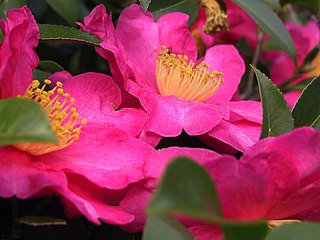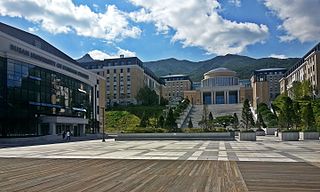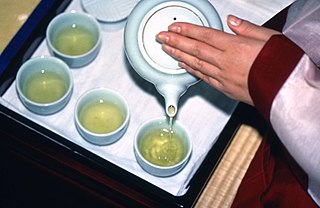
Tea is an aromatic beverage prepared by pouring hot or boiling water over cured or fresh leaves of Camellia sinensis, an evergreen shrub native to China, India and other East Asian countries. Tea is also rarely made from the leaves of Camellia taliensis. After water, it is the most widely consumed drink in the world. There are many different types of tea; some have a cooling, slightly bitter, and astringent flavour, while others have vastly different profiles that include sweet, nutty, floral, or grassy notes. Tea has a stimulating effect in humans primarily due to its caffeine content.

Camellia is a genus of flowering plants in the family Theaceae. They are found in eastern and southern Asia, from the Himalayas east to Japan and Indonesia. There are 100–300 described species, with some controversy over the exact number. There are also around 3,000 hybrids. The genus was named by Linnaeus after the Jesuit botanist Georg Joseph Kamel, who worked in the Philippines and described a species of camellia.

Green tea is a type of tea that is made from Camellia sinensis leaves and buds that have not undergone the same withering and oxidation process used to make oolong teas and black teas. Green tea originated in China, and since then its production and manufacture has spread to other countries in East Asia.

The culture of Hong Kong is primarily a mix of Chinese and Western influences, stemming from Lingnan Cantonese roots and later fusing with British culture due to British colonialism. As an international financial center dubbed "Asia’s World City", contemporary Hong Kong has also absorbed many international influences from around the world. Moreover, Hong Kong also has indigenous people and ethnic minorities from South and Southeast Asia, whose cultures all play integral parts in modern day Hong Kong culture. As a result, after the 1997 transfer of sovereignty to the People's Republic of China, Hong Kong has continued to develop a unique identity under the rubric of One Country Two Systems.

Camellia sinensis is a species of evergreen shrubs or small trees in the flowering plant family Theaceae. Its leaves and leaf buds are used to produce tea. Common names include tea plant, tea shrub, and tea tree.

Hankuk University of Foreign Studies is a private research university based in Seoul, in South Korea. HUFS consistently ranks as one of the best universities in South Korea. The university currently teaches 45 foreign languages. In addition, it contains studies in humanities, law, social sciences, business, medical science, natural sciences, and engineering.

The Catholic University of Korea is a private Roman Catholic institution of higher education in South Korea. It was established in 1855. The Catholic University of Korea operates campuses in Seoul and in the neighboring Bucheon City. The university's medical school, considered one of the most prestigious in South Korea, has eight affiliated hospitals in major cities of the country.
Lingnan culture, or Cantonese culture, refers to the regional Chinese culture of the region of Lingnan: twin provinces of Guangdong and Guangxi, the names of which mean "eastern expanse" and "western expanse" respectively.

Busan University of Foreign Studies (Korean: 부산외국어대학교), often shortened to 부산외대 and BUFS, romanized as Pusan University of Foreign Studies before 2011, is a private university in Busan, South Korea, which specializes in foreign languages.
In higher education a course is a unit of teaching that typically lasts one academic term, is led by one or more instructors, and has a fixed roster of students. A course usually covers an individual subject. Courses generally have a fixed program of sessions every week during the term, called lessons or classes. Students may receive a grade and academic credit after completion of the course. Courses can either be compulsory material or "elective". An elective is usually not a required course, but there are a certain number of non-specific electives that are required for certain majors. The entire collection of courses required to complete an academic degree is called a program of studies.

The Basic Law of Hong Kong states that English and Chinese are the two official languages of Hong Kong. During the British colonial era, English was the sole official language until 1978 but has remained a strong second language in Hong Kong. As the majority of the population in Hong Kong are descendants of migrants from China's Canton Province, the vast majority speak standard Cantonese or other Yue Chinese varieties as a first language, with smaller numbers of speakers of Hakka Language or the Teochew dialect of Southern Min. In addition, immigrants and expatriates from the West and other Asian countries have contributed much to Hong Kong's linguistic and demographic diversity. The geographical element of this diversity can be seen in the Hong Kong Language Maps, which shows oral languages from the 2011 Census, and oral and written languages from the 2016 Census. Statistics for the 27 self-reported spoken languages/dialects reported in the 2011 Census, can be found in the report: Language Use, Proficiency and Attitudes in Hong Kong.
East Asian studies is a distinct multidisciplinary field of scholarly enquiry and education that promotes a broad humanistic understanding of East Asia past and present. The field includes the study of the region's culture, written language, history and political institutions. East Asian Studies is located within the broader field of Asian studies and is also interdisciplinary in character, incorporating elements of the social sciences and humanities, among others. The field encourages scholars from diverse disciplines to exchanges ideas on scholarship as it relates to the East Asian experience and the experience of East Asia in the world. In addition, the field encourages scholars to educate others to have a deeper understanding of and appreciation and respect for, all that is East Asia and, therefore, to promote peaceful human integration worldwide.
The Institute of Asian Research (IAR) at the University of British Columbia is a research institute founded in 1978 and has been the foremost research centre in Canada for the inter-disciplinary study of Asia. With a broad geographic reach extending to China, India and South Asia, Japan, Korea and Southeast Asia, the institute conducts research and teaching in policy-relevant issues informed by language and area studies.

Shizuoka University is a national university in Shizuoka Prefecture, Japan.
The Judd A. and Marjorie Weinberg College of Arts and Sciences is the largest of the twelve schools comprising Northwestern University, located in Evanston, Illinois and downtown Chicago, Illinois.

Korean tea is a beverage consisting of boiled water infused with leaves, roots, flowers, fruits, grains, edible mushrooms, or seaweed. It may or may not contain tea leaves.

Incheon National University (INU), previously also known as University of Incheon (UI), is a national university, operated by the legal entity established by the government of Republic of Korea. INU campuses are located at multiple locations in the city of Incheon, part of Seoul Capital Area.

The School of Humanities is one of the academic units of the University of California, Irvine. Upon the school's opening in 1965, the Division of Humanities was one of the five liberal arts divisions that the campus had to offer. Samuel McCulloch was appointed as UC Irvine's founding dean of Humanities 1963. The School hosts the Thesaurus Linguae Graecae and the University of California Humanities Research Institute.
The University of Auckland Faculty of Arts, is a public university that offers courses in the arts located on Symonds Street, in Auckland.
The etymology of the various words for tea reflects the history of transmission of tea drinking culture and trade from China to countries around the world. Nearly all of the words for tea worldwide fall into three broad groups: te, cha and chai, present in English as tea, cha or char, and chai. The earliest of the three to enter English is cha, which came in the 1590s via the Portuguese, who traded in Macao and picked up the Cantonese pronunciation of the word. The more common tea form arrived in the 17th century via the Dutch, who acquired it either indirectly from the Malay teh, or directly from the tê pronunciation in Min Chinese. The third form chai originated from a northern Chinese pronunciation of cha, which travelled overland to Central Asia and Persia where it picked up a Persian ending yi, and entered English via Hindustani in the 20th century.













